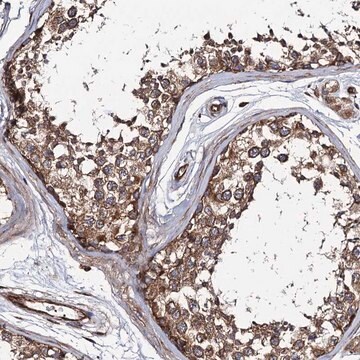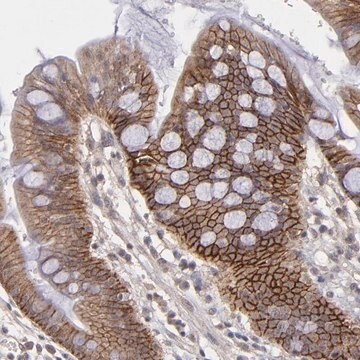一般說明
We are committed to bringing you greener alternative products, which adhere to one or more of The 12 Principles of Green Chemistry.This antibody is Preservative-free, produced without the harm or sacrifice of animals and exceptionally stable to allow for ambient shipping and storage if needed and thus aligns with "Waste Prevention", "Designing Safer Chemicals" and "Design for Energy Efficiency".
Click here for more information.
ZooMAb® antibodies represent an entirely new generation of recombinant monoclonal antibodies.
Each ZooMAb® antibody is manufactured using our proprietary recombinant expression system, purified to homogeneity, and precisely dispensed to produce robust and highly reproducible lot-to-lot consistency. Only top-performing clones are released for use by researchers. Each antibody is validated for high specificity and affinity across multiple applications, including its most commonly used application. ZooMAb® antibodies are reliably available and ready to ship when you need them.
特異性
Clone 1F3 is a ZooMAb® Rabbit recombinant monoclonal antibody that specifically detects ADAM10. It targets an epitope within 25 amino acids from the C-terminal, cytoplasmic domain.
免疫原
KLH-conjugated linear peptide corresponding to 25 amino acids from the C-terminal, cytoplasmic domain of human ADAM10.
應用
Quality Control Testing
Evaluated by Western Blotting in NIH3T3 cell lysate.
Western Blotting Analysis: A 1:1,000 dilution of this antibody detected ADAM10 in NIH3T3 cell lysate.
Tested applications
Western Blotting Analysis: A 1:1,000 dilution from a representative lot detected ADAM10 in HeLa and Jurkat cell lysates.
Affinity Binding Assay: A representative lot of this antibody bound ADAM10 with a KD of 2.3 x 10-9 in an affinity binding assay.
Immunohistochemistry (Paraffin) Analysis: A 1:100 dilution from a representative lot detected ADAM10 in human cerebral cortex and human kidney tissue sections.
Immunocytochemistry Analysis: A 1:100 dilution from a representative lot detected ADAM10 in Jurkat cells.
Note: Actual optimal working dilutions must be determined by end user as specimens, and experimental conditions may vary with the end user
標靶描述
Disintegrin and metalloproteinase domain-containing protein 10 (UniProt: O14672; also known as EC:3.4.24.81, ADAM10, CDw156, Kuzbanian protein homolog, Mammalian disintegrin-metalloprotease, CD156c) is encoded by the ADAM10 (also known as KUZ, MADM) gene (Gene ID: 102) in human. ADAM10 is a single-pass type I, zinc-binding, membrane protein with broad endopeptidase activity. Its expression has been reported in the brain, spleen, lymph node, thymus, peripheral blood leukocyte, bone marrow, cartilage, chondrocytes, and fetal liver. It is synthesized with a signal peptide (aa 1-19) and a propeptide (aa 20-213), which are subsequently cleaved off to generate the mature form that contains an extracellular domain (aa 20-672), a short transmembrane domain (aa 673-693), and a cytoplasmic domain (aa 694-748). The propeptide keeps ADAM10 in a latent form via a cysteine switch mechanism and it is cleaved by furin and PCKS7. The cysteine-rich domain (aa 555-673) of ADAM10 functions as substrate-recognition module. ADAM10 is primarily localized in the plasma membrane but is also expressed in the Golgi apparatus and in clathrin-coated vesicles. It is shown to associate with tetraspanins, which regulate its exit from the endoplasmic reticulum. It mediates the shedding of the ectodomain of various cell membrane proteins, including amyloid precursor protein and notch receptors. It is also responsible for the FasL ectodomain shedding and for the generation of the remnant ADAM10-processed FasL (FasL APL) transmembrane form. It is shown to cleave the membrane-bound precursor of TNF-a at 76-Alanine-|-Valine-77 to its mature soluble form. This ZooMAb® recombinant monoclonal antibody, generated by our propriety technology, offers significantly enhanced specificity, affinity, reproducibility, and stability over conventional monoclonals. (Ref.: Seegar, TCM., et al. (2017). Cell. 171(7); 1638-1648; Jouannet, S., et a; (2016). Cell. Mol. Life Sci. 73(9); 1895-1915).
外觀
Purified recombinant rabbit monoclonal antibody IgG, lyophilized in PBS, 5% Trehalose, normal appearance a coarse or translucent resin. The PBS/trehalose components in the ZooMAb formulation can have the appearance of a semi-solid (bead like gel) after lyophilization. This is a normal phenomenon. Please follow the recommended reconstitution procedure in the data sheet to dissolve the semi-solid, bead-like, gel-appearing material. The resulting antibody solution is completely stable and functional as proven by full functional testing. Contains no biocide or preservatives, such as azide, or any animal by-products. Larger pack sizes provided as multiples of 25 μL.
重構
300 μg/mL after reconstitution at 25 μL per vial. Please refer to guidance on suggested starting dilutions and/or titers per application and sample type.
儲存和穩定性
Recommend storage of lyophilized product at 2-8°C; Before reconstitution, micro-centrifuge vials briefly to spin down material to bottom of the vial; Reconstitute each vial by adding 25 μL of filtered lab grade water or PBS; Reconstituted antibodies can be stored at 2-8°C, or -20°C for long term storage. Avoid repeated freeze-thaws.
法律資訊
ZooMAb is a registered trademark of Merck KGaA, Darmstadt, Germany
免責聲明
Unless otherwise stated in our catalog or other company documentation accompanying the product(s), our products are intended for research use only and are not to be used for any other purpose, which includes but is not limited to, unauthorized commercial uses, in vitro diagnostic uses, ex vivo or in vivo therapeutic uses or any type of consumption or application to humans or animals.










